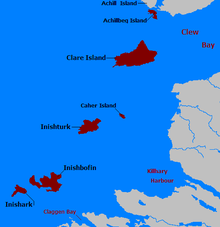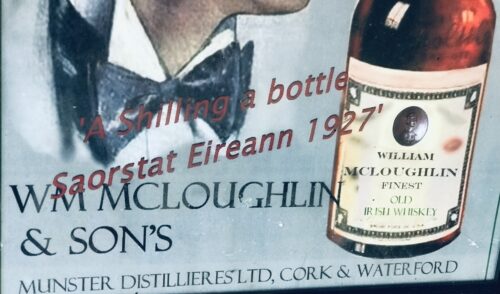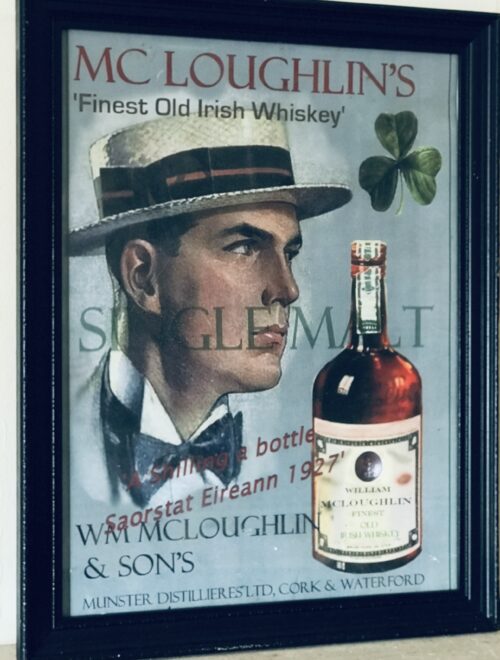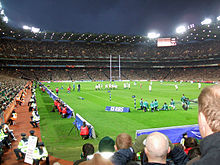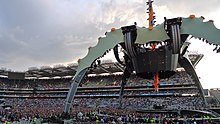-
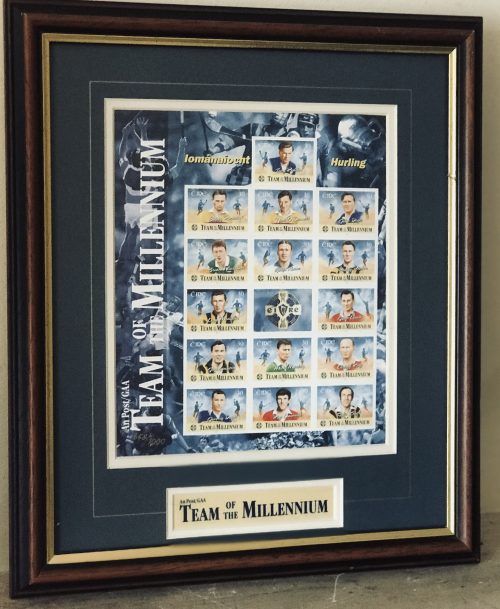 36cm x 29cm The An Post GAA Hurling Team of the Millennium was chosen in 2000 to comprise, as a fifteen-member side divided as one goalkeeper, three full-backs, three half-backs, two midfielders, three half-forwards and three full-forwards, the best hurling team of all-time. The team, announced by GAA President Seán McCague on 24 July 2000 at a special function in Croke Park, was selected by a special committee, comprising five past GAA presidents - Joe McDonagh, Con Murphy, Paddy Buggy, Pat Fanning and Séamus Ó Riain - as well as GAA director-general Liam Mulvihill and four Gaelic games journalists: Paddy Downey, Mick Dunne, Seán Óg Ó Ceallacháin and Jim O'Sullivan. The initiative was sponsored by An Post, who issued special commemorative stamps of the millennium team members.
36cm x 29cm The An Post GAA Hurling Team of the Millennium was chosen in 2000 to comprise, as a fifteen-member side divided as one goalkeeper, three full-backs, three half-backs, two midfielders, three half-forwards and three full-forwards, the best hurling team of all-time. The team, announced by GAA President Seán McCague on 24 July 2000 at a special function in Croke Park, was selected by a special committee, comprising five past GAA presidents - Joe McDonagh, Con Murphy, Paddy Buggy, Pat Fanning and Séamus Ó Riain - as well as GAA director-general Liam Mulvihill and four Gaelic games journalists: Paddy Downey, Mick Dunne, Seán Óg Ó Ceallacháin and Jim O'Sullivan. The initiative was sponsored by An Post, who issued special commemorative stamps of the millennium team members. -

 Superb Guinness advert publicising their sponsorship of the All Ireland Senior Hurling Championship. 62cm x 84cm Guinness were long time sponsors of the All Ireland Senior Hurling Championship.Hurling is an ancient sport ,played for over 2000 years by such mythical Irish legends such as Setanta, who is depicted here in this distinctive Guinness advert fighting off a fierce wolf, armed with just a Hurl and a sliotar! Following on the company’s imaginative marketing and advertising campaigns — with such slogans as ‘Not Men But Giants,’ ‘Nobody Said It Was Going To Be Easy’ and ‘The Stuff of Legend’ — other imaginative adverts brought the message that hurling is part of the Irish DNA. Other campaigns, entitled ‘It’s Alive Inside’ focused on how hurling is an integral part of Irish life and how the love of hurling is alive inside every hurling player and fan.
Superb Guinness advert publicising their sponsorship of the All Ireland Senior Hurling Championship. 62cm x 84cm Guinness were long time sponsors of the All Ireland Senior Hurling Championship.Hurling is an ancient sport ,played for over 2000 years by such mythical Irish legends such as Setanta, who is depicted here in this distinctive Guinness advert fighting off a fierce wolf, armed with just a Hurl and a sliotar! Following on the company’s imaginative marketing and advertising campaigns — with such slogans as ‘Not Men But Giants,’ ‘Nobody Said It Was Going To Be Easy’ and ‘The Stuff of Legend’ — other imaginative adverts brought the message that hurling is part of the Irish DNA. Other campaigns, entitled ‘It’s Alive Inside’ focused on how hurling is an integral part of Irish life and how the love of hurling is alive inside every hurling player and fan. -
Out of stock

 Superb Guinness advert publicising their sponsorship of the All Ireland Senior Hurling Championship-unframed print. 44cm x 60cm Guinness were long time sponsors of the All Ireland Senior Hurling Championship.Hurling is an ancient sport ,played for over 2000 years by such mythical Irish legends such as Setanta, who is depicted here in this distinctive Guinness advert fighting off a fierce wolf, armed with just a Hurl and a sliotar! Following on the company’s imaginative marketing and advertising campaigns — with such slogans as ‘Not Men But Giants,’ ‘Nobody Said It Was Going To Be Easy’ and ‘The Stuff of Legend’ — other imaginative adverts brought the message that hurling is part of the Irish DNA. Other campaigns, entitled ‘It’s Alive Inside’ focused on how hurling is an integral part of Irish life and how the love of hurling is alive inside every hurling player and fan.
Superb Guinness advert publicising their sponsorship of the All Ireland Senior Hurling Championship-unframed print. 44cm x 60cm Guinness were long time sponsors of the All Ireland Senior Hurling Championship.Hurling is an ancient sport ,played for over 2000 years by such mythical Irish legends such as Setanta, who is depicted here in this distinctive Guinness advert fighting off a fierce wolf, armed with just a Hurl and a sliotar! Following on the company’s imaginative marketing and advertising campaigns — with such slogans as ‘Not Men But Giants,’ ‘Nobody Said It Was Going To Be Easy’ and ‘The Stuff of Legend’ — other imaginative adverts brought the message that hurling is part of the Irish DNA. Other campaigns, entitled ‘It’s Alive Inside’ focused on how hurling is an integral part of Irish life and how the love of hurling is alive inside every hurling player and fan. -
Out of stock
 John Skelton was born in Armagh in 1925. A very talented artist who delighted in portraying the ordinary men and women of Rural Ireland, his works are on permanent display in the Joyce Collection of Northwestern University of Illinois,the headquarters of the ESB,Bank of Ireland and the Embassy of South Korea. Skelton started his professional career in London, where he came under influence of Euston Road School in the late 1940s. In 1946 he married Caroline, settling four years later in Dublin. He worked initially in advertising as Art Director and illustrator of books, most of them educational. After 1975 he worked full-time as a painter. He had numerous one man shows in Dublin; two in Belfast, one in Los Angeles and one in the Mystic Seaport Museum in Connecticut. Up to the late 1980s, Skelton was a frequent exhibitor in group shows, particularly the annual Royal Hibernian Academy and the Watercolour Society shows in Dublin. In recent years, however, his work was in such demand that he contributed to these less often. During the 1970s and earlier 1980s he earned a reputation as a gifted teacher and lecturer in the National College of Art and Design in Dublin. John Skelton's grave can be found at Mount Jerome Cemetery, Harold's Cross, Dublin, Ireland. Origins:Co Mayo Dimensions :29cm x 36cm
John Skelton was born in Armagh in 1925. A very talented artist who delighted in portraying the ordinary men and women of Rural Ireland, his works are on permanent display in the Joyce Collection of Northwestern University of Illinois,the headquarters of the ESB,Bank of Ireland and the Embassy of South Korea. Skelton started his professional career in London, where he came under influence of Euston Road School in the late 1940s. In 1946 he married Caroline, settling four years later in Dublin. He worked initially in advertising as Art Director and illustrator of books, most of them educational. After 1975 he worked full-time as a painter. He had numerous one man shows in Dublin; two in Belfast, one in Los Angeles and one in the Mystic Seaport Museum in Connecticut. Up to the late 1980s, Skelton was a frequent exhibitor in group shows, particularly the annual Royal Hibernian Academy and the Watercolour Society shows in Dublin. In recent years, however, his work was in such demand that he contributed to these less often. During the 1970s and earlier 1980s he earned a reputation as a gifted teacher and lecturer in the National College of Art and Design in Dublin. John Skelton's grave can be found at Mount Jerome Cemetery, Harold's Cross, Dublin, Ireland. Origins:Co Mayo Dimensions :29cm x 36cm -
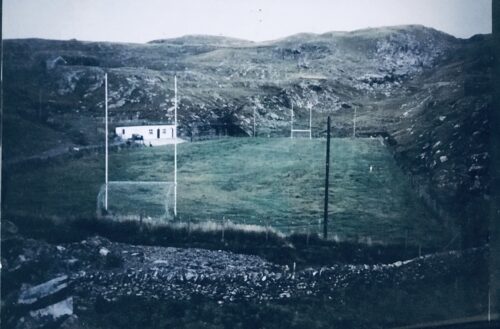
 26cm x 33cm Fantastic shot of the most westerly GAA pitch in Ireland and prob in Western Europe-the pitch on Care Island where the resourceful locals have mangaged to produce a decent playing surface on the only flat patch of land on the island ! Inishturk (Inis Toirc in Irish, meaning Wild Boar Island) is an inhabited island of County Mayo, in Ireland.
26cm x 33cm Fantastic shot of the most westerly GAA pitch in Ireland and prob in Western Europe-the pitch on Care Island where the resourceful locals have mangaged to produce a decent playing surface on the only flat patch of land on the island ! Inishturk (Inis Toirc in Irish, meaning Wild Boar Island) is an inhabited island of County Mayo, in Ireland.Geography
The island lies about 15 km (9 mi) off the coast; its highest point reaches 189.3 m (621.1 ft) above sea level. Between Inisturk and Clare Island lies Caher Island. It has a permanent population of 58 people.There are two main settlements, both on the more sheltered eastern end of the island, Ballyheer and Garranty. Bellavaun and Craggy are abandoned settlements. The British built a Martello tower on the western coast during the Napoleonic Wars. Inisturk has the highest per capita donation rate towards the RNLI in the whole of Ireland.History
Inishturk has been inhabited on and off since 4,000 BCE and has been inhabited permanently since at least 1700. Some of the more recent inhabitants are descended from evacuees from Inishark to the southwest. The social club Mountain Common is situated on the hill that separates the two settlements.Recent history
In 1993 Inishturk Community centre was opened, this community centre doubles as a library and a pub. In June 2014 the ESB commissioned three new Broadcrown BCP 110-50 100kVA diesel generators to supply electricity to the island The ESB have operated a diesel power station on the island since the 1980s Inishturk gained international attention in 2016 after a number of websites claimed that the island would welcome any American "refugees" fleeing a potential Donald Trump presidency.These claims were used as one example of the type of "fake news" that arose during the 2016 US presidential election campaign. As of November 2016, no changes to inward migration have been reported. The island is home to a primary school on the island which in 2011 had only 3 pupils, this believed to be the smallest primary school in IrelandDemographics
The table below reports data on Inisturk's population taken from Discover the Islands of Ireland (Alex Ritsema, Collins Press, 1999) and the Censusof Ireland.Historical population Year Pop. ±% 1841 577 — 1851 174 −69.8% 1861 110 −36.8% 1871 112 +1.8% 1881 116 +3.6% 1891 135 +16.4% 1901 135 +0.0% 1911 132 −2.2% 1926 101 −23.5% Year Pop. ±% 1936 107 +5.9% 1946 125 +16.8% 1951 123 −1.6% 1956 110 −10.6% 1961 108 −1.8% 1966 92 −14.8% 1971 83 −9.8% 1979 85 +2.4% 1981 76 −10.6% Year Pop. ±% 1986 90 +18.4% 1991 78 −13.3% 1996 83 +6.4% 2002 72 −13.3% 2006 58 −19.4% 2011 53 −8.6% 2016 51 −3.8% Source: Central Statistics Office. "CNA17: Population by Off Shore Island, Sex and Year". CSO.ie. Retrieved October 12, 2016. Transport[edit]
Prior to 1997 there was no scheduled ferry service and people traveled to and from the islands using local fishing boats. Since then a ferry service operates from Roonagh Quay, Louisburgh, County Mayo.[13] The pier was constructed during the 1980s by the Irish government, around this time the roads on the island were paved.[14] -
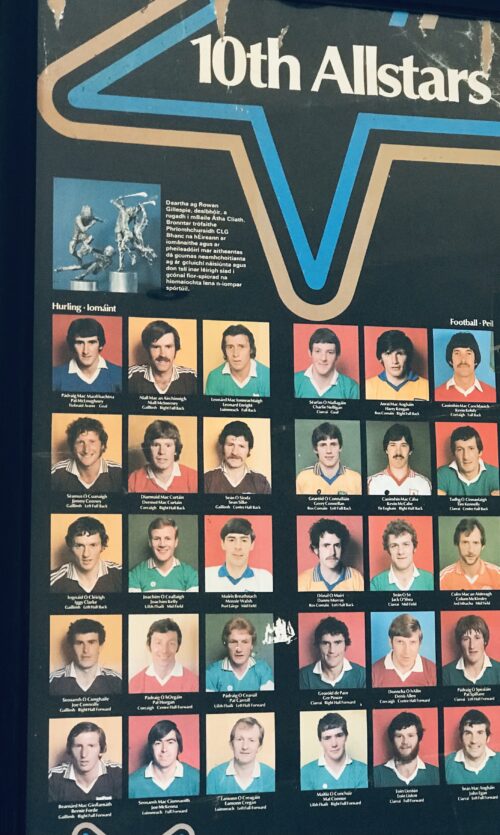
 85cm x 45cm Dingle Co Kerry The Gaelic Athletic Association-Gaelic Players' Association All Stars Awards (often known simply as the All Stars) are awarded annually to the best player in each of the 15 playing positions in Gaelic football and hurling. Additionally, one player in each code is selected as Player of the Year. The awards have since 2011 been presented jointly by the Gaelic Athletic Association and the representative body for inter-county players, the Gaelic Players Association. Each player who receives a nomination is given a medallion marking the milestone.These are considered to be "the most coveted sporting award scheme in the country".Since the 1960s there had been a tradition of annually selecting the best player in each position, in football and hurling, to create a special team of the year. Between 1963 and 1967 these players received what was known as the Cú Chulainn award. In 1971 these awards were formalised into the annual GAA All Star Awards. In 2006 the Gaelic Players Association launched a parallel award scheme entitled the GPA Gaelic Team of the Year (often referred to as the GPA Awards). An annual award was also given by the GPA to the Footballer of the Year and the Hurler of the Year. In 2011 it was announced that the GAA All Stars Awards, which had been sponsored in recent years by Vodafone, and the GPA Awards would merge under the sponsorship of car manufacturer Opel. The move announced by Christy Cooney saw the achievements of players recognised jointly for the first time in October 2011. The All Stars team comprises the best player in each position, regardless of club or county affiliation. The composition of the All Star teams are decided on the basis of a shortlist compiled by a selection committee of sports journalists from the national media, while the overall winners are chosen by inter-county players themselves. The award is regarded by players as the highest accolade available to them, due to it being picked by their peers. The awards are presented at a gala banquet in November following the end of the Championship season. Both men's teams are honoured with a special holiday where they play an exhibition game. Since 1971 over 1,000 players have been honoured with All Stars Awards. Damien Martin of Offaly was the first ever recipient of the award, while in 2004 Paul Galvin of Kerry became the 1,000th winner of the award. Carlow and Longford are the only county in Ireland not to receive an award in either sport. In September 2017 PwC became the new sponsors of the All Star Awards on a four year deal, with the awards being re-named The PwC All-Stars.
85cm x 45cm Dingle Co Kerry The Gaelic Athletic Association-Gaelic Players' Association All Stars Awards (often known simply as the All Stars) are awarded annually to the best player in each of the 15 playing positions in Gaelic football and hurling. Additionally, one player in each code is selected as Player of the Year. The awards have since 2011 been presented jointly by the Gaelic Athletic Association and the representative body for inter-county players, the Gaelic Players Association. Each player who receives a nomination is given a medallion marking the milestone.These are considered to be "the most coveted sporting award scheme in the country".Since the 1960s there had been a tradition of annually selecting the best player in each position, in football and hurling, to create a special team of the year. Between 1963 and 1967 these players received what was known as the Cú Chulainn award. In 1971 these awards were formalised into the annual GAA All Star Awards. In 2006 the Gaelic Players Association launched a parallel award scheme entitled the GPA Gaelic Team of the Year (often referred to as the GPA Awards). An annual award was also given by the GPA to the Footballer of the Year and the Hurler of the Year. In 2011 it was announced that the GAA All Stars Awards, which had been sponsored in recent years by Vodafone, and the GPA Awards would merge under the sponsorship of car manufacturer Opel. The move announced by Christy Cooney saw the achievements of players recognised jointly for the first time in October 2011. The All Stars team comprises the best player in each position, regardless of club or county affiliation. The composition of the All Star teams are decided on the basis of a shortlist compiled by a selection committee of sports journalists from the national media, while the overall winners are chosen by inter-county players themselves. The award is regarded by players as the highest accolade available to them, due to it being picked by their peers. The awards are presented at a gala banquet in November following the end of the Championship season. Both men's teams are honoured with a special holiday where they play an exhibition game. Since 1971 over 1,000 players have been honoured with All Stars Awards. Damien Martin of Offaly was the first ever recipient of the award, while in 2004 Paul Galvin of Kerry became the 1,000th winner of the award. Carlow and Longford are the only county in Ireland not to receive an award in either sport. In September 2017 PwC became the new sponsors of the All Star Awards on a four year deal, with the awards being re-named The PwC All-Stars.
F00tball : Charlie Nelligan (Kerry), Harry Keegan (Roscommon), Kevin Kehilly (Cork), Gerry Connellan (Roscommon), Kevin McCabe (Tyrone), Tim Kennelly (Kerry), Danny Murray (Roscommon), Jack O'Shea (Kerry), Colm McKinstry (Armagh), Ger Power (Kerry), Dinny Allen (Cork), Pat Spillane (Kerry), Matt Connor (Offaly), Eoin Liston (Kerry), John Egan (KerryPos. Player Team Appearances GK  Pat McLoughney
Pat McLoughneyTipperary 2 RCB  Niall McInerney
Niall McInerneyGalway 2 FB  Leonard Enright
Leonard EnrightLimerick 1 LCB  Jimmy Cooney
Jimmy CooneyGalway 1 RWB  Dermot McCurtain
Dermot McCurtainCork 2 CB  Sean Silke
Sean SilkeGalway 2 LWB  Iggy Clarke
Iggy ClarkeGalway 4 MD  Joachim Kelly
Joachim KellyOffaly 1 MD  Mossie Walsh
Mossie WalshWaterford 1 RWF  Joe Connolly
Joe ConnollyGalway 1 CF  Pat Horgan
Pat HorganCork 1 LWF  Pat Carroll
Pat CarrollOffaly 1 RCF  Bernie Forde
Bernie FordeGalway 1 FF  Joe McKenna
Joe McKennaLimerick 5 LCF  Éamonn Cregan
Éamonn CreganLimerick 3 -

 Fantastic panoramic photo of the modern Croke Park,one of the most iconic sporting venues in the World. Dimensions: 36cm x110cm Croke Park (Irish: Páirc an Chrócaigh) is a Gaelic games stadium located in Dublin, Ireland. Named after Archbishop Thomas Croke, it is sometimes called Croker by GAA fans and locals. It serves as both the principal stadium and headquarters of the Gaelic Athletic Association (GAA). Since 1891 the site has been used by the GAA to host Gaelic sports, including the annual All-Ireland in Gaelic football and hurling. A major expansion and redevelopment of the stadium ran from 1991–2005, raising capacity to its current 82,300 spectators. This makes Croke Park the third-largest stadium in Europe, and the largest not usually used for association football. Other events held at the stadium include the opening and closing ceremonies of the 2003 Special Olympics, and numerous musical concerts. In 2012, Irish pop group Westlife sold out the stadium in record-breaking time: less than 5 minutes. From 2007–10, Croke Park hosted home matches of the Ireland national rugby union team and the Republic of Ireland national football team, while their new Aviva Stadium was constructed. This use of Croke Park for non-Gaelic sports was controversial and required temporary changes to GAA rules. In June 2012, the stadium hosted the closing ceremony of the 50th International Eucharistic Congress during which Pope Benedict XVI gave an address over video link.
Fantastic panoramic photo of the modern Croke Park,one of the most iconic sporting venues in the World. Dimensions: 36cm x110cm Croke Park (Irish: Páirc an Chrócaigh) is a Gaelic games stadium located in Dublin, Ireland. Named after Archbishop Thomas Croke, it is sometimes called Croker by GAA fans and locals. It serves as both the principal stadium and headquarters of the Gaelic Athletic Association (GAA). Since 1891 the site has been used by the GAA to host Gaelic sports, including the annual All-Ireland in Gaelic football and hurling. A major expansion and redevelopment of the stadium ran from 1991–2005, raising capacity to its current 82,300 spectators. This makes Croke Park the third-largest stadium in Europe, and the largest not usually used for association football. Other events held at the stadium include the opening and closing ceremonies of the 2003 Special Olympics, and numerous musical concerts. In 2012, Irish pop group Westlife sold out the stadium in record-breaking time: less than 5 minutes. From 2007–10, Croke Park hosted home matches of the Ireland national rugby union team and the Republic of Ireland national football team, while their new Aviva Stadium was constructed. This use of Croke Park for non-Gaelic sports was controversial and required temporary changes to GAA rules. In June 2012, the stadium hosted the closing ceremony of the 50th International Eucharistic Congress during which Pope Benedict XVI gave an address over video link.City and Suburban Racecourse
The area now known as Croke Park was owned in the 1880s by Maurice Butterly and known as the City and Suburban Racecourse, or Jones' Road sports ground. From 1890 it was also used by the Bohemian Football Club. In 1901 Jones' Road hosted the IFA Cup football final when Cliftonville defeated Freebooters.History
Recognising the potential of the Jones' Road sports ground a journalist and GAA member, Frank Dineen, borrowed much of the £3,250 asking price and bought the ground in 1908. In 1913 the GAA came into exclusive ownership of the plot when they purchased it from Dineen for £3,500. The ground was then renamed Croke Park in honour of Archbishop Thomas Croke, one of the GAA's first patrons. In 1913, Croke Park had only two stands on what is now known as the Hogan stand side and grassy banks all round. In 1917, a grassy hill was constructed on the railway end of Croke Park to afford patrons a better view of the pitch. This terrace was known originally as Hill 60, later renamed Hill 16 in memory of the 1916 Easter Rising. It is erroneously believed to have been built from the ruins of the GPO, when it was constructed the previous year in 1915. In the 1920s, the GAA set out to create a high capacity stadium at Croke Park. Following the Hogan Stand, the Cusack Stand, named after Michael Cusack from Clare (who founded the GAA and served as its first secretary), was built in 1927. 1936 saw the first double-deck Cusack Stand open with 5,000 seats, and concrete terracing being constructed on Hill 16. In 1952 the Nally Stand was built in memorial of Pat Nally, another of the GAA founders. Seven years later, to celebrate the 75th anniversary of the GAA, the first cantilevered "New Hogan Stand" was opened. The highest attendance ever recorded at an All-Ireland Senior Football Championship Final was 90,556 for Offaly v Down in 1961. Since the introduction of seating to the Cusack stand in 1966, the largest crowd recorded has been 84,516.Bloody Sunday
During the Irish War of Independence on 21 November 1920 Croke Park was the scene of a massacre by the Royal Irish Constabulary (RIC). The Police, supported by the British Auxiliary Division, entered the ground and began shooting into the crowd, killing or fatally wounding 14 civilians during a Dublin-Tipperary Gaelic football match. The dead included 13 spectators and Tipperary player Michael Hogan. Posthumously, the Hogan stand built in 1924 was named in his honour. These shootings, on the day which became known as Bloody Sunday, were a reprisal for the killing of 15 people associated with the Cairo Gang, a group of British Intelligence officers, by Michael Collins' 'squad' earlier that day.Dublin Rodeo
In 1924, American rodeo promoter, Tex Austin, staged the Dublin Rodeo, Ireland's first professional rodeo at Croke Park Stadium. For seven days, with two shows each day from August 18 to August 24, sell out crowds saw cowboys and cowgirls from Canada, the United States, Mexico, Argentina and Australia compete for rodeo championship titles.Canadian bronc riders such as Andy Lund and his brother Art Lund, trick riders such as Ted Elder and Vera McGinnis were among the contestants. British Pathe filmed some of the rodeo events.Stadium design
In 1984 the organisation decided to investigate ways to increase the capacity of the old stadium. The design for an 80,000 capacity stadium was completed in 1991. Gaelic sports have special requirements as they take place on a large field. A specific requirement was to ensure the spectators were not too far from the field of play. This resulted in the three-tier design from which viewing games is possible: the main concourse, a premium level incorporating hospitality facilities and an upper concourse. The premium level contains restaurants, bars and conference areas. The project was split into four phases over a 14-year period. Such was the importance of Croke Park to the GAA for hosting big games, the stadium did not close during redevelopment. During each phase different parts of the ground were redeveloped, while leaving the rest of the stadium open. Big games, including the annual All-Ireland Hurling and Football finals, were played in the stadium throughout the development.Phase one – New Cusack Stand
The first phase of construction was to build a replacement for Croke Park's Cusack Stand. A lower deck opened for use in 1994. The upper deck opened in 1995. Completed at a cost of £35 million, the new stand is 180 metres long, 35 metres high, has a capacity for 27,000 people and contains 46 hospitality suites. The new Cusack Stand contains three tiers from which viewing games is possible: the main concourse, a premium level incorporating hospitality facilities and finally an upper concourse. One end of the pitch was closer to the stand after this phase, as the process of slightly re-aligning the pitch during the redevelopment of the stadium began. The works were carried out by Sisk Group.Phase two – Davin Stand
Phase Two of the development started in late 1998 and involved extending the new Cusack Stand to replace the existing Canal End terrace. It involved reacquiring a rugby pitch that had been sold to Belvedere College in 1910 by Frank Dineen. In payment and part exchange, the college was given the nearby Distillery Road sportsgrounds.[19] It is now known as The Davin Stand (Irish: Ardán Dáimhím), after Maurice Davin, the first president of the GAA. This phase also saw the creation of a tunnel which was later named the Ali tunnel in honour of Muhammad Ali and his fight against Al Lewis in July 1972 in Croke Park.Phase three – Hogan Stand
Phase Three saw the building of the new Hogan Stand. This required a greater variety of spectator categories to be accommodated including general spectators, corporate patrons, VIPs, broadcast and media services and operation staff. Extras included a fitted-out mezzanine level for VIP and Ard Comhairle (Where the dignitaries sit) along with a top-level press media facility. The end of Phase Three took the total spectator capacity of Croke Park to 82,000.Phase four – Nally Stand & Nally End/Dineen Hill 16 terrace
After the 2003 Special Olympics, construction began in September 2003 on the final phase, Phase Four. This involved the redevelopment of the Nally Stand, named after the athlete Pat Nally, and Hill 16 into a new Nally End/Dineen Hill 16 terrace. While the name Nally had been used for the stand it replaced, the use of the name Dineen was new, and was in honour of Frank Dineen, who bought the original stadium for the GAA in 1908, giving it to them in 1913. The old Nally Stand was taken away and reassembled in Pairc Colmcille, home of Carrickmore GAA in County Tyrone. The phase four development was officially opened by the then GAA President Seán Kelly on 14 March 2005. For logistical reasons (and, to a degree, historical reasons), and also to provide cheaper high-capacity space, the area is a terrace rather than a seated stand, the only remaining standing-room in Croke Park. Unlike the previous Hill, the new terrace was divided into separate sections – Hill A (Cusack stand side), Hill B (behind the goals) and the Nally terrace (on the site of the old Nally Stand). The fully redeveloped Hill has a capacity of around 13,200, bringing the overall capacity of the stadium to 82,300. This made the stadium the second biggest in the EU after the Camp Nou, Barcelona. However, London's new Wembley stadium has since overtaken Croke Park in second place. The presence of terracing meant that for the brief period when Croke Park hosted international association football during 2007–2009, the capacity was reduced to approximately 73,500, due to FIFA's statutes stating that competitive games must be played in all-seater stadiums.Pitch
The pitch in Croke Park is a soil pitch that replaced the Desso GrassMaster pitch laid in 2002. This replacement was made after several complaints by players and managers that the pitch was excessively hard and far too slippery. Since January 2006, a special growth and lighting system called the SGL Concept has been used to assist grass growing conditions, even in the winter months. The system, created by Dutch company SGL (Stadium Grow Lighting), helps in controlling and managing all pitch growth factors, such as light, temperature, CO2, water, air and nutrients.Floodlighting
With the 2007 Six Nations clash with France and possibly other matches in subsequent years requiring lighting the GAA installed floodlights in the stadium (after planning permission was granted). Indeed, many other GAA grounds around the country have started to erect floodlights as the organisation starts to hold games in the evenings, whereas traditionally major matches were played almost exclusively on Sunday afternoons. The first game to be played under these lights at Croke Park was a National Football League Division One match between Dublin and Tyrone on 3 February 2007 with Tyrone winning in front of a capacity crowd of over 81,000 – which remains a record attendance for a National League game, with Ireland's Six Nations match with France following on 11 February. Temporary floodlights were installed for the American Bowl game between Chicago Bears and Pittsburgh Steelers on the pitch in 1997, and again for the 2003 Special Olympics.Concert
Date Performer(s) Opening act(s) Tour/Event Attendance Notes 29 June 1985 U2 In Tua Nua, R.E.M., The Alarm, Squeeze The Unforgettable Fire Tour 57,000 First Irish act to have a headline concert. Part of the concert was filmed for the group's documentary Wide Awake in Dublin. 28 June 1986 Simple Minds Once Upon A Time Tour Guest appearance by Bono 27 June 1987 U2 Light A Big Fire, The Dubliners, The Pogues, Lou Reed The Joshua Tree Tour 114,000 28 June 1987 Christy Moore, The Pretenders, Lou Reed, Hothouse Flowers 28 June 1996 Tina Turner Brian Kennedy Wildest Dreams Tour 40,000/40,000 16 May 1997 Garth Brooks World Tour II 18 May 1997 29 May 1998 Elton John & Billy Joel Face to Face 1998 30 May 1998 24 June 2005 U2 The Radiators from Space, The Thrills, The Bravery, Snow Patrol, Paddy Casey, Ash Vertigo Tour 246,743 25 June 2005 27 June 2005 20 May 2006 Bon Jovi Nickelback Have a Nice Day Tour 81,327 9 June 2006 Robbie Williams Basement Jaxx Close Encounters Tour 6 October 2007 The Police Fiction Plane The Police Reunion Tour 81,640 Largest attendance of the tour. 31 May 2008 Celine Dion Il Divo Taking Chances World Tour 69,725 Largest attendance for a solo female act 1 June 2008 Westlife Shayne Ward Back Home Tour 85,000 Second Irish act to have a headline concert. Largest attendance of the tour. Part of the concert was filmed for the group's documentary and concert DVD 10 Years of Westlife - Live at Croke Park Stadium. 14 June 2008 Neil Diamond 13 June 2009 Take That The Script Take That Present: The Circus Live 24 July 2009 U2 Glasvegas, Damien Dempsey U2 360° Tour 243,198 25 July 2009 Kaiser Chiefs, Republic of Loose 27 July 2009 Bell X1, The Script The performances of "New Year's Day" and "I'll Go Crazy If I Don't Go Crazy Tonight" were recorded for the group's live album U22 and for the band's remix album Artificial Horizon and the live EP Wide Awake in Europe, respectively. 5 June 2010 Westlife Wonderland, WOW, JLS, Jedward Where We Are Tour 86,500 Largest attendance of the tour. 18 June 2011 Take That Pet Shop Boys Progress Live 154,828 19 June 2011 22 June 2012 Westlife Jedward, The Wanted, Lawson Greatest Hits Tour 187,808[24] The 23 June 2012 date broke the stadium record for selling out its tickets in four minutes. Eleventh largest attendance at an outdoor stadium worldwide. Largest attendance of the tour and the band's music career history. Part of the concert was filmed for the group's documentary and concert DVD The Farewell Tour - Live in Croke Park. 23 June 2012 26 June 2012 Red Hot Chili Peppers Noel Gallagher's High Flying Birds, The Vaccines I'm with You World Tour 23 May 2014 One Direction 5 Seconds of Summer Where We Are Tour 235,008 24 May 2014 25 May 2014 20 June 2015 The Script & Pharrell Williams No Sound Without Silence Tour 74,635 24 July 2015 Ed Sheeran x Tour 162,308 25 July 2015 27 May 2016 Bruce Springsteen The River Tour 2016 160,188 29 May 2016 9 July 2016 Beyoncé Chloe x Halle, Ingrid Burley The Formation World Tour 68,575 8 July 2017 Coldplay AlunaGeorge, Tove Lo A Head Full of Dreams Tour[25] 80,398 22 July 2017 U2 Noel Gallagher's High Flying Birds The Joshua Tree Tour 2017 80,901 17 May 2018 The Rolling Stones The Academic No Filter Tour 64,823 15 June 2018 Taylor Swift Camila Cabello, Charli XCX Taylor Swift's Reputation Stadium Tour 136.000 Swift became the first woman headline two concerts in a row there. 16 June 2018 7 July 2018 Michael Bublé Emeli Sandé 24 May 2019 Spice Girls Jess Glynne Spice World - 2019 UK Tour 5 July 2019 Westlife James Arthur Wild Youth The 20 Touror The Twenty Tour The 5 July 2019 date sold out its tickets in six minutes. Second date released were also sold out in under forty-eight hours. 6 July 2019 Non-Gaelic games
There was great debate in Ireland regarding the use of Croke Park for sports other than those of the GAA. As the GAA was founded as a nationalist organisation to maintain and promote indigenous Irish sport, it has felt honour-bound throughout its history to oppose other, foreign (in practice, British), sports. In turn, nationalist groups supported the GAA as the prime example of purely Irish sporting culture. Until its abolition in 1971, rule 27 of the GAA constitution stated that a member of the GAA could be banned from playing its games if found to be also playing association football, rugby or cricket. That rule was abolished but rule 42 still prohibited the use of GAA property for games with interests in conflict with the interests of the GAA. The belief was that rugby and association football were in competition with Gaelic football and hurling, and that if the GAA allowed these sports to use their ground it might be harmful to Gaelic games, while other sports, not seen as direct competitors with Gaelic football and hurling, were permitted, such as the two games of American football (Croke Park Classic college football game between The University of Central Florida and Penn State, and an American Bowl NFL preseason game between the Chicago Bears and the Pittsburgh Steelers) on the Croke Park pitch during the 1990s.[27] On 16 April 2005, a motion to temporarily relax rule No. 42 was passed at the GAA Annual Congress. The motion gives the GAA Central Council the power to authorise the renting or leasing of Croke Park for events other than those controlled by the Association, during a period when Lansdowne Road – the venue for international soccer and rugby matches – was closed for redevelopment. The final result was 227 in favour of the motion to 97 against, 11 votes more than the required two-thirds majority. In January 2006, it was announced that the GAA had reached agreement with the Football Association of Ireland (FAI) and Irish Rugby Football Union (IRFU) to stage two Six Nations games and four soccer internationals at Croke Park in 2007 and in February 2007, use of the pitch by the FAI and the IRFU in 2008 was also agreed.These agreements were within the temporary relaxation terms, as Lansdowne Road was still under redevelopment until 2010. Although the GAA had said that hosted use of Croke Park would not extend beyond 2008, irrespective of the redevelopment progress, fixtures for the 2009 Six Nations rugby tournament saw the Irish rugby team using Croke park for a third season. 11 February 2007 saw the first rugby union international to be played there. Ireland were leading France in a Six Nations clash, but lost 17–20 after conceding a last minute (converted) try. Raphael Ibanez scored the first try in that match; Ronan O'Gara scored Ireland's first ever try in Croke Park. A second match between Ireland and England on 24 February 2007 was politically symbolic because of the events of Bloody Sunday in 1920.There was considerable concern as to what reaction there would be to the singing of the British national anthem "God Save the Queen". Ultimately the anthem was sung without interruption or incident, and applauded by both sets of supporters at the match, which Ireland won by 43–13 (their largest ever win over England in rugby). On 2 March 2010, Ireland played their final international rugby match against a Scotland team that was playing to avoid the wooden spoon and hadn't won a championship match against Ireland since 2001. Outside half, Dan Parks inspired the Scots to a 3-point victory and ended Irish Hopes of a triple crown. On 24 March 2007, the first association football match took place at Croke Park. The Republic of Ireland took on Wales in UEFA Euro 2008 qualifying Group D, with a Stephen Ireland goal securing a 1–0 victory for the Irish in front of a crowd of 72,500. Prior to this, the IFA Cup had been played at the then Jones' Road in 1901, but this was 12 years before the GAA took ownership. Negotiations took place for the NFL International Series's 2011 game to be held at Croke Park but the game was awarded to Wembley Stadium.World record attendance
On 2 May 2009, Croke Park was the venue for a Heineken Cup rugby semi-final, in which Leinster defeated Munster 25–6. The attendance of 82,208 set a new world record attendance for a club rugby union game.[35] This record stood until 31 March 2012 when it was surpassed by an English Premiership game between Harlequins and Saracens at Wembley Stadium which hosted a crowd of 83,761.This was beaten again in 2016 in the Top 14 final at the Nou Camp which hosted a crowd of 99,124Skyline tour
A walkway, known under a sponsorship deal as Etihad Skyline Croke Park, opened on 1 June 2012.From 44 metres above the ground, it offers views of Dublin city and the surrounding area.The Olympic Torch was brought to the stadium and along the walkway on 6 June 2012.GAA Hall of Fame
On 11 February 2013, the GAA opened the Hall of Fame section in the Croke Park museum. The foundation of the award scheme is the Teams of the Millennium the football team which was announced in 1999 and the hurling team in 2000 and all 30 players were inducted into the hall of fame along with Limerick hurler Eamonn Cregan and Offaly footballer Tony McTague who were chosen by a GAA sub-committee from the years 1970–74.New inductees will be chosen on an annual basis from the succeeding five-year intervals as well as from years preceding 1970. In April 2014, Kerry legend Mick O'Dwyer, Sligo footballer Micheál Kerins, along with hurlers Noel Skehan of Kilkenny and Pat McGrath of Waterford became the second group of former players to receive hall of fame awards. Statue of Michael Cusack outside the Croke Park GAA Museum
Statue of Michael Cusack outside the Croke Park GAA Museum -
Out of stock

 62cm x 72cm Scarriff Co Clare This extremely rare print commemorates three Catholic priests killed during the bloody War of Independence between the IRA and British Crown Forces : Fr James O’Callaghan Clogheen,Canon Magnier Dunmanway and Fr Michael Griffin Galway .Indeed the 100 year anniversaries of three callous murders are all due in the next few months. Fr O Callaghan was shot in cold blood in Cork city by a group of drunken Black and Tans.Canon Magnier,an elderly priest in poor health, was shot along with a young parishioner outside the village of Dunmanway in Co Cork and Fr Griffin was taken from his home and assassinated in Galway .An estimated 20,000 people attended his funeral. This poignant and extremely rare print,dating from that period pays homage to these holy men who were all cruelly murdered in cold blood whilst unarmed by tyrannical British Military forces.The notorious murder of a young West of Ireland priest who was lured from his home before being shot in the head and buried in a bog by British forces is to be commemorated with a series of events in Galway City next year. The disappearance and murder of Fr Michael Griffin (28) sent shock waves across Ireland in November 1920, prompting a front-page news story in the New York Times, a cable expressing outrage from the Bishop of Chicago, and tough questions about British atrocities in Ireland in the British Parliament. It was one of the most notorious killings of the War of Independence when reprisals were commonplace, and the hated Black and Tans – recruited from Britain to put the rebellious Irish in their place – roamed the land. The body of the popular young curate was discovered in an unmarked grave in bogland a few miles west of Galway City six days after his disappearance and, from the outset, locals in Galway blamed the Black and Tans for the shocking crime. An estimated crowd of 12,000 people gathered outside St Joseph’s Church in Galway City for his Requiem Mass, which was concelebrated by the Archbishop of Tuam, the bishops of Galway and Clonfert, and almost 150 priests from across the West of Ireland. A native of East Galway, Fr Griffin was suspected of having republican sympathies by British forces at the time, who were angered by the disappearance of a local primary school principal, Patrick Joyce, a week before the young priest went missing. Joyce was accused of feeding information to the crown forces by members of the Irish Republican Brotherhood (IRB), who had intercepted five of his letters at the mail sorting office in Galway. Collusion with the despised British crown forces was seen as treason at the time and Joyce was shot in the head by republicans after they presented him with evidence at a secret trial in an isolated house outside the city. November 1920 was a particularly violent time in Galway. A pregnant young woman had been shot by the Black and Tans outside her family home in rural Ardrahan, two Galway city men had been shot dead, and republican prisoners were on hunger strike in Galway gaol. Men from the area had been interned without trial, there was a curfew across the city, and British forces were highly suspicious of young priests like Fr Griffin, who were believed to have republican sympathies. Members of the St Joseph’s Parish Council formed a new committee this week to organize a series of events in Fr Griffin’s memory in Galway in November of next year. Although the city will be in “party mode” when Galway becomes the European Capital of Culture in 2020, committee chairman Cllr John Connolly believes people need to remember their history and the sacrifices made in Galway to secure Irish freedom.“A lot of people don’t realise how tough life was in Galway during the War of Independence. Between the beginning of September and the end of November 1920, you had the death of Seamus Quirke, Sean Mulvoy, and Michael Walsh, who was a member of the Urban District Council,” Connolly told IrishCentral this week. “They were all known republicans and republican sympathisers. You also had the death of Patrick Joyce, who was the principal of Bearna National School, who was of a different political persuasion. He was considered an informer, who was informing the British forces in Galway of the activities of the Irish Republican Brotherhood (IRB).” The British believed Fr Griffin had given the last rites to Walsh and Quirke, two well-known republicans in Galway. They also believed he may have heard the last confession of Patrick Joyce and that he knew who had abducted him. Controversy surrounded Joyce’s case for decades, as his body was only found in a field to the west of Galway in the 1990s. His direct family – who emigrated to Australia – always maintained his innocence of collusion allegations. “The Black and Tans really went on the rampage in Galway when Joyce disappeared, throwing grenades into houses, killing livestock belonging to people, and burning the premises of the Galway Express newspaper,” recalled Connolly this week. “Fr Griffin went missing on November 14 and his body was found on the 20th. Locals believed that people in the area knew where the body was, but they were afraid of uncovering it in case of reprisals from British forces, who were searching for Patrick Joyce at that stage,” said Cllr Connolly. It is known that three men called to Fr Griffin’s house at Montpellier Terrace late on a Sunday night and that he agreed to accompany them. A neighbor heard him speak to the men, who were Irish, at the front door and he was never seen again. Historians believe the British shot him at their nearby base at Lenaboy Castle, Taylor’s Hill, that same night and then dumped him in an unmarked grave. Locals found the body on the following Saturday evening but were so afraid of the British that they waited until 7 am on Sunday morning before bringing his body to St Joseph’s Church in the city. Fr Griffin was found with a bullet in his head, indicating he had been shot at close range. “He was brought in on a horse and cart. They had to disguise the cart with large milk churns, in case the British forces stopped them. The British were still looking for Patrick Joyce and they were upset that he had been kidnapped. They saw his disappearance as a direct threat to their own intelligence operation,” explained Connolly. “The idea that a clergyman would be treated like this was a new low I think for the British forces in the city and, indeed in the country, that they had taken this action against a priest.” Fr Griffin from Gurteen, Co Galway, had a great love for the Irish language and was popular for his dealings with the old, the young, and the poor. He was moved by the injustice he witnessed around him every day due to the British occupation. As soon as he was reported missing, locals in Galway blamed the British crown forces. After his disappearance, Bishop O’Dea and the priests of Galway issued a statement to condemn his abduction from his home. “We cannot but hold the British Government responsible for this outrage upon the Catholic priesthood of Ireland,” they said. “He has been secretly forced from his house in the dead of night by undisciplined men. Without warrant, or charge, or proof of wrongdoing he has been deprived of his liberty and, for all we know, his life. Unhappily, the only uncommon feature in this case is that he is a priest; the crime in this respect being almost unique; in as much as every civilised country in the world recognises priests as men of peace, and treats them as such.” Connolly and Fr Martin Downey, Parish Priest of St Joseph’s, have formed a new committee to organize a series of events to remember the popular young priest next November. “Really and truly, Fr Griffin got no trial. It’s fitting that his centenary should be commemorated because it was a bleak time in Galway. That a highly respected member of the community was taken out and killed like this, we do need to remind ourselves that Galway was a dark place at the time and the sacrifice of those who lost their lives should not be forgotten,” said Connolly.
62cm x 72cm Scarriff Co Clare This extremely rare print commemorates three Catholic priests killed during the bloody War of Independence between the IRA and British Crown Forces : Fr James O’Callaghan Clogheen,Canon Magnier Dunmanway and Fr Michael Griffin Galway .Indeed the 100 year anniversaries of three callous murders are all due in the next few months. Fr O Callaghan was shot in cold blood in Cork city by a group of drunken Black and Tans.Canon Magnier,an elderly priest in poor health, was shot along with a young parishioner outside the village of Dunmanway in Co Cork and Fr Griffin was taken from his home and assassinated in Galway .An estimated 20,000 people attended his funeral. This poignant and extremely rare print,dating from that period pays homage to these holy men who were all cruelly murdered in cold blood whilst unarmed by tyrannical British Military forces.The notorious murder of a young West of Ireland priest who was lured from his home before being shot in the head and buried in a bog by British forces is to be commemorated with a series of events in Galway City next year. The disappearance and murder of Fr Michael Griffin (28) sent shock waves across Ireland in November 1920, prompting a front-page news story in the New York Times, a cable expressing outrage from the Bishop of Chicago, and tough questions about British atrocities in Ireland in the British Parliament. It was one of the most notorious killings of the War of Independence when reprisals were commonplace, and the hated Black and Tans – recruited from Britain to put the rebellious Irish in their place – roamed the land. The body of the popular young curate was discovered in an unmarked grave in bogland a few miles west of Galway City six days after his disappearance and, from the outset, locals in Galway blamed the Black and Tans for the shocking crime. An estimated crowd of 12,000 people gathered outside St Joseph’s Church in Galway City for his Requiem Mass, which was concelebrated by the Archbishop of Tuam, the bishops of Galway and Clonfert, and almost 150 priests from across the West of Ireland. A native of East Galway, Fr Griffin was suspected of having republican sympathies by British forces at the time, who were angered by the disappearance of a local primary school principal, Patrick Joyce, a week before the young priest went missing. Joyce was accused of feeding information to the crown forces by members of the Irish Republican Brotherhood (IRB), who had intercepted five of his letters at the mail sorting office in Galway. Collusion with the despised British crown forces was seen as treason at the time and Joyce was shot in the head by republicans after they presented him with evidence at a secret trial in an isolated house outside the city. November 1920 was a particularly violent time in Galway. A pregnant young woman had been shot by the Black and Tans outside her family home in rural Ardrahan, two Galway city men had been shot dead, and republican prisoners were on hunger strike in Galway gaol. Men from the area had been interned without trial, there was a curfew across the city, and British forces were highly suspicious of young priests like Fr Griffin, who were believed to have republican sympathies. Members of the St Joseph’s Parish Council formed a new committee this week to organize a series of events in Fr Griffin’s memory in Galway in November of next year. Although the city will be in “party mode” when Galway becomes the European Capital of Culture in 2020, committee chairman Cllr John Connolly believes people need to remember their history and the sacrifices made in Galway to secure Irish freedom.“A lot of people don’t realise how tough life was in Galway during the War of Independence. Between the beginning of September and the end of November 1920, you had the death of Seamus Quirke, Sean Mulvoy, and Michael Walsh, who was a member of the Urban District Council,” Connolly told IrishCentral this week. “They were all known republicans and republican sympathisers. You also had the death of Patrick Joyce, who was the principal of Bearna National School, who was of a different political persuasion. He was considered an informer, who was informing the British forces in Galway of the activities of the Irish Republican Brotherhood (IRB).” The British believed Fr Griffin had given the last rites to Walsh and Quirke, two well-known republicans in Galway. They also believed he may have heard the last confession of Patrick Joyce and that he knew who had abducted him. Controversy surrounded Joyce’s case for decades, as his body was only found in a field to the west of Galway in the 1990s. His direct family – who emigrated to Australia – always maintained his innocence of collusion allegations. “The Black and Tans really went on the rampage in Galway when Joyce disappeared, throwing grenades into houses, killing livestock belonging to people, and burning the premises of the Galway Express newspaper,” recalled Connolly this week. “Fr Griffin went missing on November 14 and his body was found on the 20th. Locals believed that people in the area knew where the body was, but they were afraid of uncovering it in case of reprisals from British forces, who were searching for Patrick Joyce at that stage,” said Cllr Connolly. It is known that three men called to Fr Griffin’s house at Montpellier Terrace late on a Sunday night and that he agreed to accompany them. A neighbor heard him speak to the men, who were Irish, at the front door and he was never seen again. Historians believe the British shot him at their nearby base at Lenaboy Castle, Taylor’s Hill, that same night and then dumped him in an unmarked grave. Locals found the body on the following Saturday evening but were so afraid of the British that they waited until 7 am on Sunday morning before bringing his body to St Joseph’s Church in the city. Fr Griffin was found with a bullet in his head, indicating he had been shot at close range. “He was brought in on a horse and cart. They had to disguise the cart with large milk churns, in case the British forces stopped them. The British were still looking for Patrick Joyce and they were upset that he had been kidnapped. They saw his disappearance as a direct threat to their own intelligence operation,” explained Connolly. “The idea that a clergyman would be treated like this was a new low I think for the British forces in the city and, indeed in the country, that they had taken this action against a priest.” Fr Griffin from Gurteen, Co Galway, had a great love for the Irish language and was popular for his dealings with the old, the young, and the poor. He was moved by the injustice he witnessed around him every day due to the British occupation. As soon as he was reported missing, locals in Galway blamed the British crown forces. After his disappearance, Bishop O’Dea and the priests of Galway issued a statement to condemn his abduction from his home. “We cannot but hold the British Government responsible for this outrage upon the Catholic priesthood of Ireland,” they said. “He has been secretly forced from his house in the dead of night by undisciplined men. Without warrant, or charge, or proof of wrongdoing he has been deprived of his liberty and, for all we know, his life. Unhappily, the only uncommon feature in this case is that he is a priest; the crime in this respect being almost unique; in as much as every civilised country in the world recognises priests as men of peace, and treats them as such.” Connolly and Fr Martin Downey, Parish Priest of St Joseph’s, have formed a new committee to organize a series of events to remember the popular young priest next November. “Really and truly, Fr Griffin got no trial. It’s fitting that his centenary should be commemorated because it was a bleak time in Galway. That a highly respected member of the community was taken out and killed like this, we do need to remind ourselves that Galway was a dark place at the time and the sacrifice of those who lost their lives should not be forgotten,” said Connolly.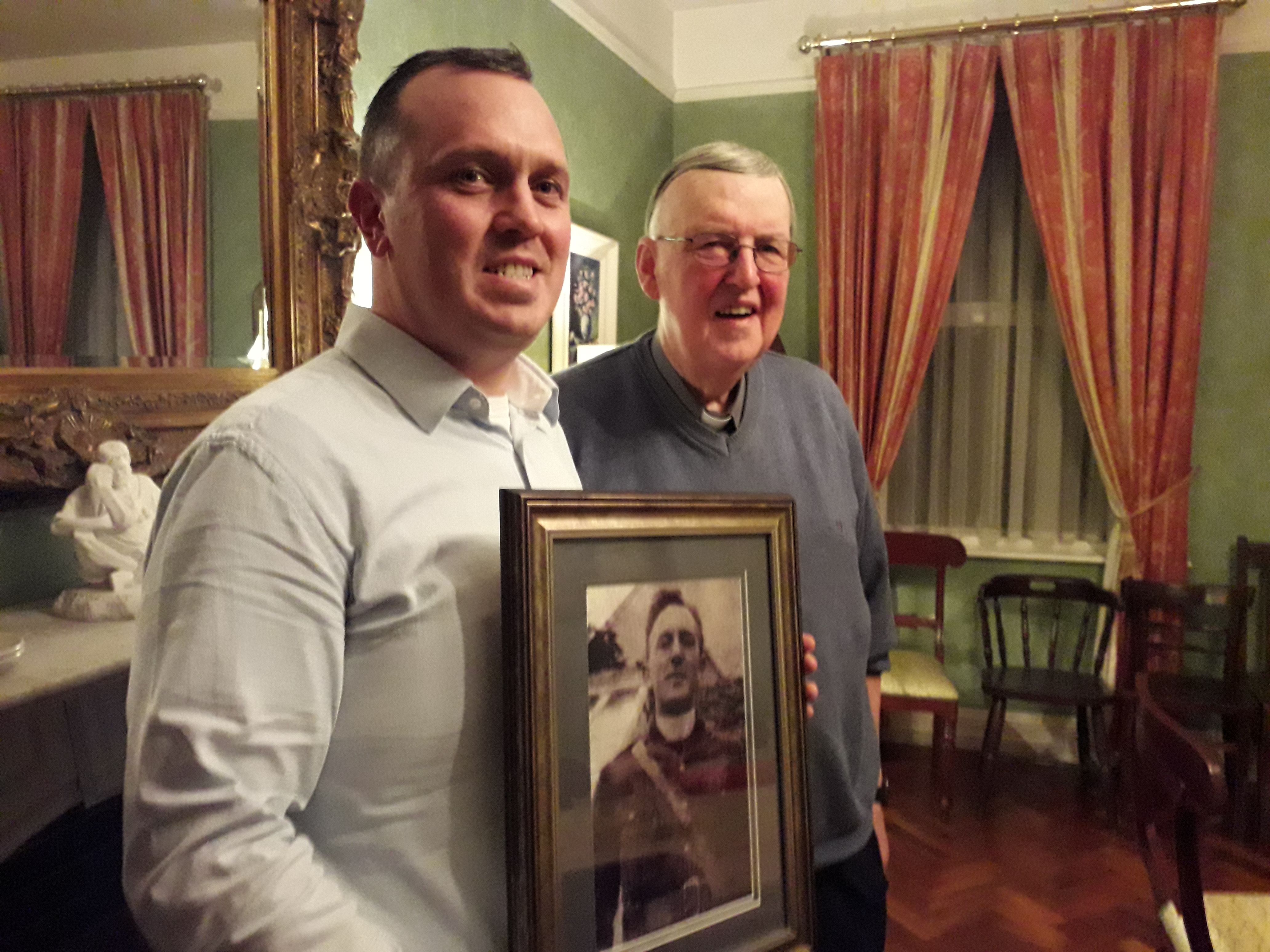 2
2John Connolly and Fr Martin Downey, with a photo of Fr Griffin, courtesy of Ciaran Tierney Digital Storyteller.
Reprisal Killing of Cork PriestIn the aftermath of the devestating attack on a police patrol at Blackpool in Cork City on May 14, 1921, in which three RIC members lost their life, large forces of military and police flooded the area and much of the Blackpool area was ransacked. Several arrests were made and throughout the city, rumours circulated of major military operations involving widespread savage reprisals. Just before 4am, on the following morning, the Sundays Well home of Alderman Liam De Roiste was raided by a group of masked men, all members of the Royal Irish Constabulary. He himself was not at home, but Father Seamus O'Callaghan, a curate based at Clogheen on the outskirts of the city, happened to be in the house at the time. Having been awakened by the hammering at the door, Fr O'Callaghan went to the window and informed the men outside that De Roiste was not at home. The front door was then broken in and at least one of the police ran up the stairs and fired a number of shots at the priest, who fell mortally wounded. The assailaints then made their escape. Fr O'Callaghan died a number of hours later. A native of Newcestown, West Cork, he was widely admired by the people of Cork having, as a young man, closely identified himself with the Nationalist cause. His funeral was attended by many thousands, despite widespread intimidation of the mourners by crown forces. He is buried in the grounds of the Church of the Most Precious Blood, Clogheen. -

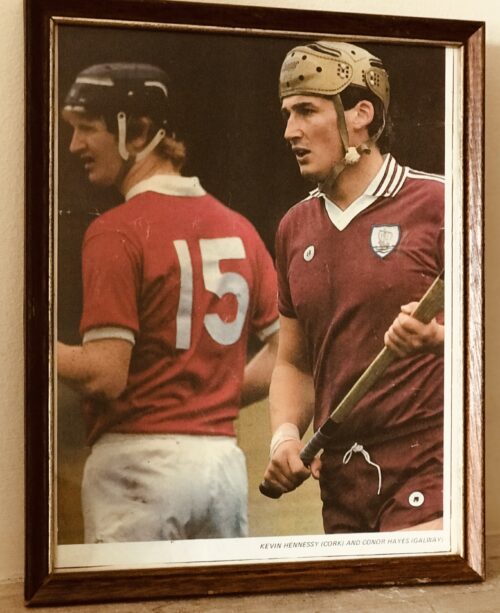 Real retro GAA hurling photo here of Kevin Hennessy of Cork & Conor Hayes of Galway marking each other in an All Ireland Final.Conor is wearing what appears to be a very old Cooper Ice hockey Head guard and it became his signature piece during his career as Galway Captain and Full Back. Kiltormer Co Galway 29cm x 23cm Conor Hayes was a three-time All-Star. He made his debut for the Galway senior hurlers during the 1979 championship and went on to play a key role for the Tribesmen for over a decade, winning three All-Irelands and two National Leagues. He was captain when Galway won back-to-back All-Ireland titles in 1987 and 1988. Conor is also an All-Ireland winner at club level, having achieved the highest honour in club hurling with Kiltormer in 1992. He is the holder of two Connacht club championships and three Galway hurling championships with Kiltormer and was named on the Galway Hurling Team of the Millennium. Kevin Hennessy (born 8 March 1961) is an Irish retired hurler who played as a left-corner forward for the Cork senior team. Born in Midleton, County Cork, Hennessy first arrived on the inter-county scene at the age of 18 when he first linked up with the Cork minor team, before later lining out with the under-21 side. He made his senior debut in the 1982 championship. Hennessy went on to play a key part for over a decade, and won three All-Ireland medals and seven Munster medals. He was an All-Ireland runner-up on three occasions. Hennessy represented the Munster inter-provincial team in the early stages of his career, winning two Railway Cup medals. At club level he won one All-Ireland medal, two Munster medals and four championship medals with Midleton. Throughout his career Hennessy made 22 championship appearances for Cork. He retired from inter-county hurling following the conclusion of the 1993 championship.
Real retro GAA hurling photo here of Kevin Hennessy of Cork & Conor Hayes of Galway marking each other in an All Ireland Final.Conor is wearing what appears to be a very old Cooper Ice hockey Head guard and it became his signature piece during his career as Galway Captain and Full Back. Kiltormer Co Galway 29cm x 23cm Conor Hayes was a three-time All-Star. He made his debut for the Galway senior hurlers during the 1979 championship and went on to play a key role for the Tribesmen for over a decade, winning three All-Irelands and two National Leagues. He was captain when Galway won back-to-back All-Ireland titles in 1987 and 1988. Conor is also an All-Ireland winner at club level, having achieved the highest honour in club hurling with Kiltormer in 1992. He is the holder of two Connacht club championships and three Galway hurling championships with Kiltormer and was named on the Galway Hurling Team of the Millennium. Kevin Hennessy (born 8 March 1961) is an Irish retired hurler who played as a left-corner forward for the Cork senior team. Born in Midleton, County Cork, Hennessy first arrived on the inter-county scene at the age of 18 when he first linked up with the Cork minor team, before later lining out with the under-21 side. He made his senior debut in the 1982 championship. Hennessy went on to play a key part for over a decade, and won three All-Ireland medals and seven Munster medals. He was an All-Ireland runner-up on three occasions. Hennessy represented the Munster inter-provincial team in the early stages of his career, winning two Railway Cup medals. At club level he won one All-Ireland medal, two Munster medals and four championship medals with Midleton. Throughout his career Hennessy made 22 championship appearances for Cork. He retired from inter-county hurling following the conclusion of the 1993 championship. -
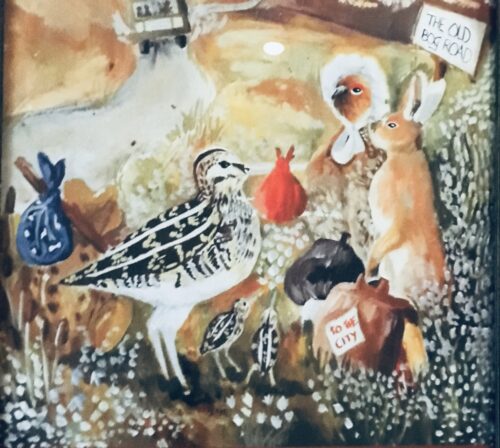
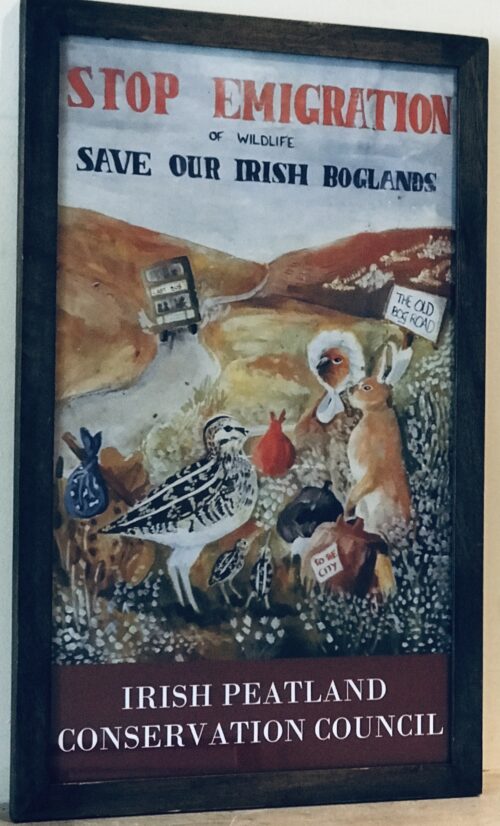 Unique,interesting and humorous framed poster from the Irish Peatland Conservation Council pleading with the powers that be to enact legislation to help conserve the incredible and diverse ecosystem that are the Irish Boglands. 53cm x 33cm Birr Co OffalyIreland has some of the most internationally important peatlands but they are under serious threat.
Unique,interesting and humorous framed poster from the Irish Peatland Conservation Council pleading with the powers that be to enact legislation to help conserve the incredible and diverse ecosystem that are the Irish Boglands. 53cm x 33cm Birr Co OffalyIreland has some of the most internationally important peatlands but they are under serious threat."Bogs," writes John Feehan, "are places of enchantment. This is due in large measure to the immense natural diversity of the peatland landscape, but also to its unique atmosphere. The bogs are great, open expanses with distant horizons. You feel drawn to them as though they awakened an echo deep within us of the open savannah landscapes in which our human kind had its origins several million years ago."
Peatlands in Ireland include raised and blanket bogs, fens, as well as wet and dry heath. As well as being beautiful and characteristic of the Irish landscape, bogs and other peatlands are harsh, wet, nutrient-poor environments, hosting unusual assemblages of habitats and species specially adapted to these conditions. We have a high proportion of Europe's remaining peatlands and we therefore have a special international responsibility for their conservation. Unfortunately, peatland areas are under serious threat in Ireland at present. A recent map shows that peat soils comprise some 20.6% of Ireland's national land area. In geographical terms alone, therefore, impacts on peatland habitats represent one of Ireland's biggest environmental issues. This has long been the case. As far back as 1987 the Union of Professional and Technical Civil Servants commented that “The need to safeguard as many midland (raised) bogs as possible before they are lost forever to peat extraction is the most urgent issue in Irish nature conservation.” Drivers of peatland biodiversity loss include habitat change and exploitation (e.g. through drainage and peat extraction), invasive alien species, nutrient pollution and climate change. In addition to their biodiversity value, peatlands are also very important carbon sinks, and act as a buffer - like large sponges - helping to protect us from flooding. When bogs are drained and harvested, they cannot perform these functions effectively. Indeed, drained and degraded bogs go from being carbon sinks to very large carbon sources. It has been estimated that the annual emissions from Ireland's degraded peatlands are roughly equal to Ireland's annual transport emissions from cars. The only way to reverse this trend is to block drains and restore our peatlands. This will have benefits in terms of nature conservation, climate change and flood prevention and alleviation. -
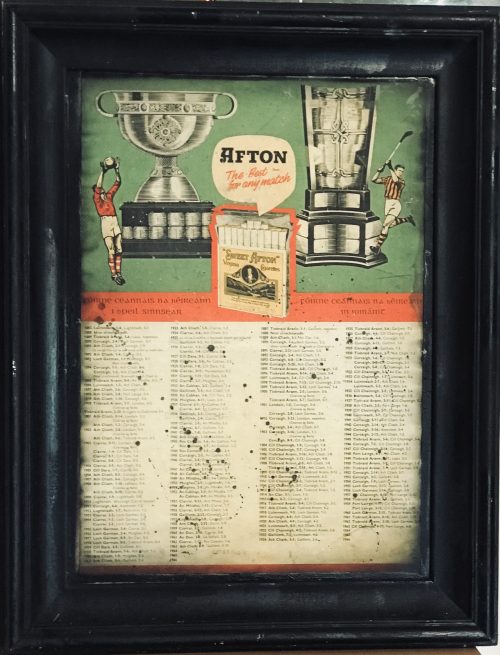 Fantastic original Sweet Afton Virginia Cigarettes Advertising print with beautiful images of the two holy grails in Irish Sport-The Sam Maguire Cup for the All Ireland Gaelic football Champions and the Liam McCarthy Cup for the All Ireland Hurling Champions.A footballer from Cork and a hurler from Kilkenny are featured in this charming print. Also the winners and shorelines from All Irelands from 1887 to 1963 are included underneath.Acharming addition to any wall space Dimensions: 75cm x 55cm Origins;Aughrim Co Galway UnglazedOrigins : Co Kilkenny Dimensions : 48cm x 62cm
Fantastic original Sweet Afton Virginia Cigarettes Advertising print with beautiful images of the two holy grails in Irish Sport-The Sam Maguire Cup for the All Ireland Gaelic football Champions and the Liam McCarthy Cup for the All Ireland Hurling Champions.A footballer from Cork and a hurler from Kilkenny are featured in this charming print. Also the winners and shorelines from All Irelands from 1887 to 1963 are included underneath.Acharming addition to any wall space Dimensions: 75cm x 55cm Origins;Aughrim Co Galway UnglazedOrigins : Co Kilkenny Dimensions : 48cm x 62cm A 20-pack of Sweet Afton cigarettes with a text warning in both Irish and English stating "Smoking kills".
A 20-pack of Sweet Afton cigarettes with a text warning in both Irish and English stating "Smoking kills".Product type Cigarette Sweet Afton was an Irish brand of short, unfiltered cigarettes made with Virginia tobacco and produced by P.J. Carroll & Co., Dundalk, Ireland, now a subsidiary of British American Tobacco. The Sweet Afton brand was launched by Carroll's in 1919 to celebrate the link between Dundalk and the national poet of Scotland, Robert Burns. Burns' eldest sister, Agnes, lived in Dundalk from 1817 until her death in 1834 and was buried in the cemetery of St. Nicholas's Church in the town. Carroll's thought that the brand would only be successful in Scotland if the carton simply had an image of Burns, or Scottish name on the packet, so the people of Dundalk were canvassed and the name Sweet Afton was chosen. The name is taken from Burns' poem "Sweet Afton", which itself takes its title from the poem's first stanza: Flow gently, sweet Afton, amang thy green braes Flow gently, I’ll sing thee a song in thy praise My Mary’s asleep by they murmuring stream Flow gently, sweet Afton, disturb not her dream. A larger version of the cigarette was also marketed under the brand name Afton Major. This name served as inspiration for Carroll's later Majorbrand of tipped cigarettes. As of Autumn 2011, British American Tobacco no longer manufactures Sweet Afton cigarettes. The text "Thank you for your loyalty, unfortunately Sweet Afton will not be available in the future. However Major, our other Irish brand with similar tobacco will still be widely available for purchase." was written on a sticker that was put on the last line of packs, before it went out of production. The brand proved particularly popular with post World War II Rive Gauche Paris. It was reputed to be Jean-Paul Sartre's preferred cigarette, and also featured prominently in Louis Malle's film Le Feu Follet, as well as a number of other Nouvelle Vague films.Margot Tenenbaum (played by Gwyneth Paltrow) from Wes Anderson's 2001 film The Royal Tenenbaums also smokes Sweet Aftons. Thomas Shelby, in Peaky Blinders, smokes Sweet Aftons. They are also the favoured brand of Gerhard Selb, the eponymous private investigator in the trilogy by Bernhard SchlinkOld Afton advertisement on a pub in Wexford

